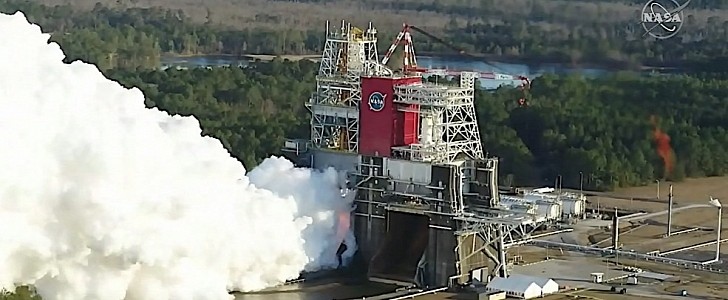This Saturday, the most powerful rocket humans have ever built, the Space Launch System (SLS), was to conduct a hot fire test, the last in a longer series meant to validate the workhorse of the Artemis program. For reasons yet unknown, the test failed.
The plan called for 700,000 gallons of cryogenic fuel to be loaded into the tanks of the rocket, and for the four RS-25 engines of the core stage to be fired at the same time. The test was supposed to last for eight or so minutes, simulating the duration of an actual launch.
The loading of the fuel and the firing of the engines went on without a hitch, but the SLS had problems with duration. The engines stayed lit for just a little over a minute before shutting down.
Presently, NASA does not know what caused the rapid shutdown, but says it is investigating. We are not informed on how or if this failure affects the schedule of the SLS development.
"Saturday’s test was an important step forward to ensure that the core stage of the SLS rocket is ready for the Artemis I mission, and to carry crew on future missions,” said in a statement NASA Administrator Jim Bridenstine.
“Although the engines did not fire for the full duration, the team successfully worked through the countdown, ignited the engines, and gained valuable data to inform our path forward.”
The Space Launch System is the rocket that will put humans back on the Moon decades after the stunning achievement of late 1960s. There are plans to have the uncrewed Artemis I mission take off later this year, followed by the crewed Artemis II in 2023. This mission will only go the the Moon and head back, and we’ll have to wait for Artemis III of 2024 to witness a Moon landing.
The SLS is made up of the core stage with four RS-25 engines and two side boosters. Combined, they are capable of generating 8.8 million pounds of thrust during launch. During their short burn this weekend, the RS engines put out 1.6 million pounds of thrust, but the rocket didn’t go anywhere as, this being a test and all, it was anchored on the test stand at the Stennis Space Center in Mississippi.
The action starts in the video below at the 2 hours 7 minutes mark.
The loading of the fuel and the firing of the engines went on without a hitch, but the SLS had problems with duration. The engines stayed lit for just a little over a minute before shutting down.
Presently, NASA does not know what caused the rapid shutdown, but says it is investigating. We are not informed on how or if this failure affects the schedule of the SLS development.
"Saturday’s test was an important step forward to ensure that the core stage of the SLS rocket is ready for the Artemis I mission, and to carry crew on future missions,” said in a statement NASA Administrator Jim Bridenstine.
“Although the engines did not fire for the full duration, the team successfully worked through the countdown, ignited the engines, and gained valuable data to inform our path forward.”
The Space Launch System is the rocket that will put humans back on the Moon decades after the stunning achievement of late 1960s. There are plans to have the uncrewed Artemis I mission take off later this year, followed by the crewed Artemis II in 2023. This mission will only go the the Moon and head back, and we’ll have to wait for Artemis III of 2024 to witness a Moon landing.
The SLS is made up of the core stage with four RS-25 engines and two side boosters. Combined, they are capable of generating 8.8 million pounds of thrust during launch. During their short burn this weekend, the RS engines put out 1.6 million pounds of thrust, but the rocket didn’t go anywhere as, this being a test and all, it was anchored on the test stand at the Stennis Space Center in Mississippi.
The action starts in the video below at the 2 hours 7 minutes mark.





